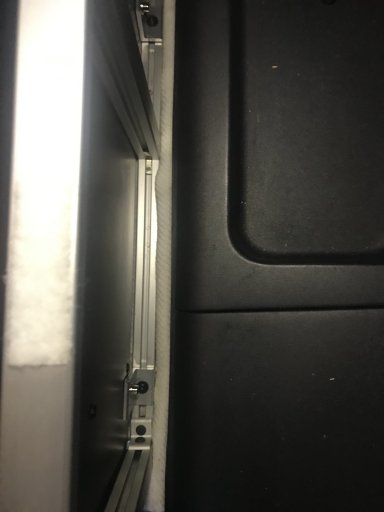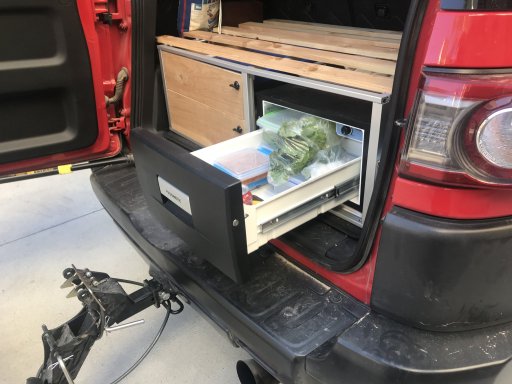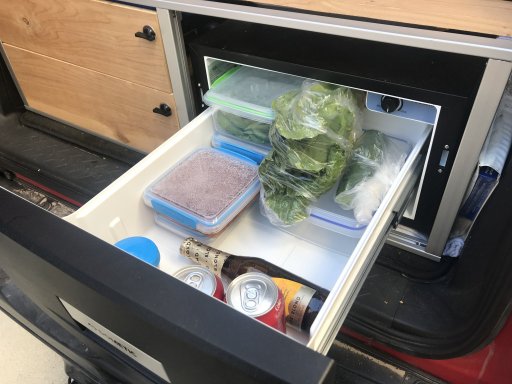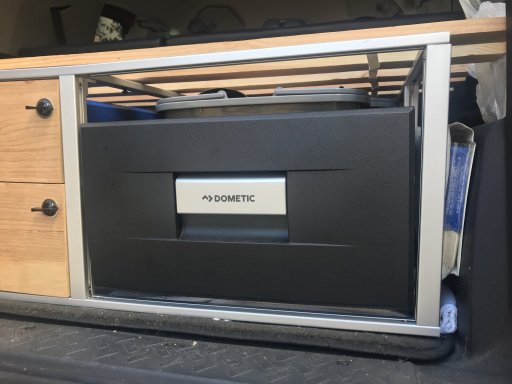
Enthusiast III
Here's my recent galley/sleeping platform build, in case it helps inspire anyone planning to build a galley/sleeping platform system. This is in an FJ Cruiser.
My guiding principles were:
1. Keep it as lightweight as possible
2. Accommodate a drawer fridge
3. Drawer system had to be easily removable (no permanent attachments)
4. Platform bed needed to be removable and easily transportable to/from vehicle
5. Rear seats had to stay in the vehicle
6. Had to look good :)
Here’s what the finished drawer system looks like. The opening on the right will accommodate a Dometic CD-30 or equivalent drawer fridge, and a smaller drawer above it (coming in the future). All the brackets are already in place so mounting these things later on will be very easy.
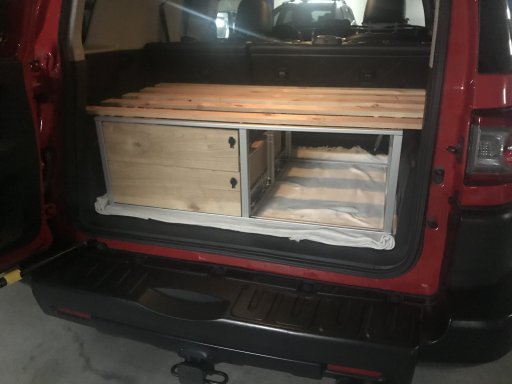
To make the platform for the bed, I made three aluminum bars that engage with the back of the drawer frame on one side, and sit on top of the folded-up rear seats on the other. If you don't have the latter in your vehicle you would have to make some sort of leg for these bed spanners. The wood slats, which are pinned to the bars so the system becomes rigid after installed, obviously go on top of the three spanner bars. The slats and bars fit into a long duffel bag that is in a closet until I am going on a camping trip.
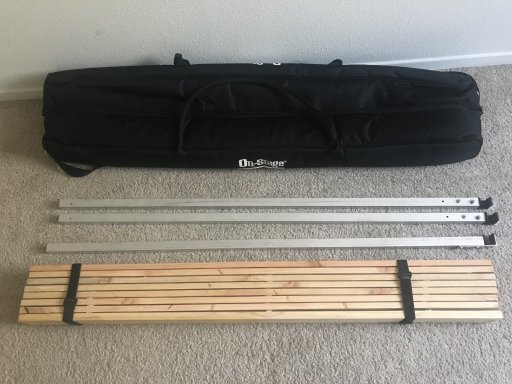
The drawer frame structure is lightweight and made out of extruded aluminum. You will notice it is an open frame, as the aluminum is strong enough as it is and thus I did not need walls, etc. and I wanted to keep the weight down. It is held firmly in place in the rear with two turnbuckles (only the left one is installed in this picture). You will see that the rear seat backs are reclined flat, and the bottoms are pivoted up. The top of these provides the support for the bed spanners.
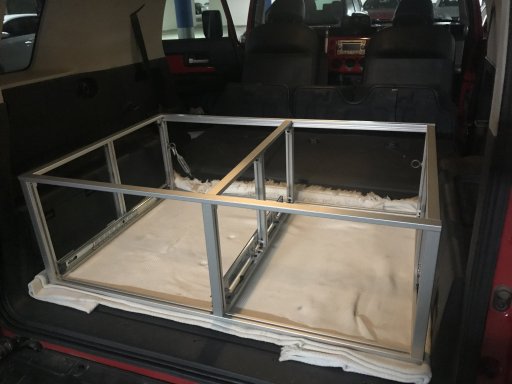
The drawer system is made of 1/2” Baltic plywood, assembled with pocket screws. I was planning to dissasemble the whole thing after making sure everything worked well and reassemble with wood glue and the pocket screws, but the structure was so strong with just the screws I did not bother with the glue. The big drawer slides on a 26” drawer glide and the one inside slides on a 24” drawer glide. They are push to open, so I installed a cam lock to hold them firmly in place while traveling.
The bottom (internal) drawer is meant for pots and pans, plates, and other miscellaneous cooking gear. The reason why that comes out of the big drawer instead of directly out of the aluminum frame is because if I was cooking and I needed to take something out of the bottom drawer I would have to shut off the stove and close it so I could open the bottom drawer and retrieve something from there. The nesting drawers solves this problem.
The big drawer has the cooking platform above which holds the 2 burner cooking stove, which in turn is attached to the floor of the platform with industrial strength Velcro. The 1lb propane bottle goes in the gap behind the stove, and connects to the stove with a flexible hose/regulator instead of the solid brass pipe/regulator that comes with the stove (which goes to the right of the stove, but I did not have the space for).
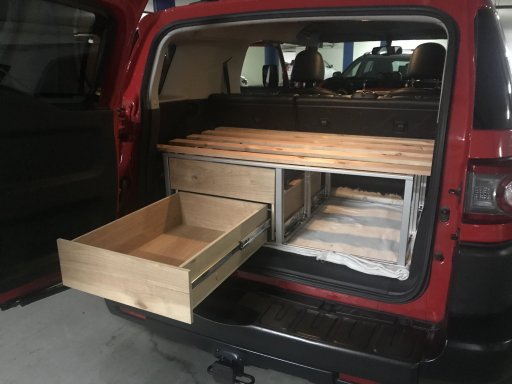
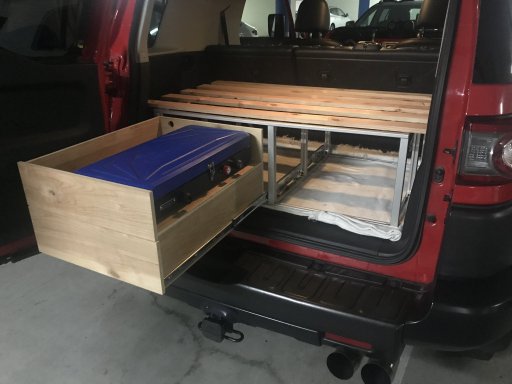
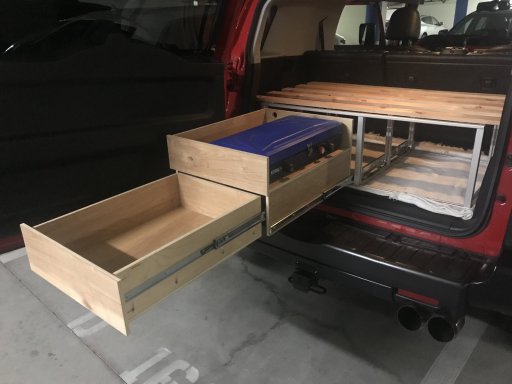
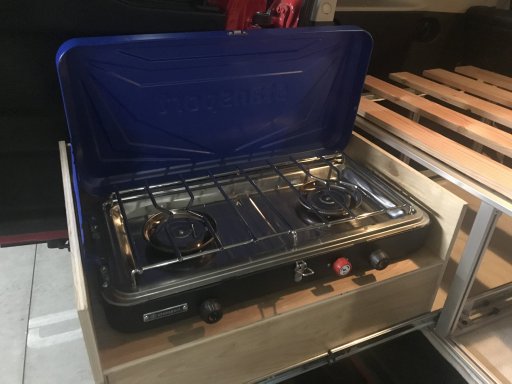
To install the platform bed, the front seats slide forward. The back rests also recline forward. It turns out that the driver seat back rest in the FJ Cruiser does not recline forward as much as the passenger seat so I had to perform surgery on the mechanism that controls this so now both recline the same, and provides sufficient room for the bed comfortable for a 6'1" person.
The rear seat bottoms recline forward and the back rests recline down, and the bed spanner bars attach to the top/rear of the drawer frame on one end using an L bracket and sit on the top part of the bottom seats on the other end. On top of that goes the wood slats and on top of that the mattress pad. The space above is not big, but it’s sufficient to turn around. The biggest challenge is getting in and out of the vehicle, but anyone reasonably fit can easily do it. If someone is claustrofobic this might not be a good solution but it does provide comfortable sleeping space for two. And, under the three bars (and on top of the rear back rests) there’s a giant 22cm tall space (and as wide as the vehicle and 113cm long) for storage of water jerry can and any other things you will need to carry.
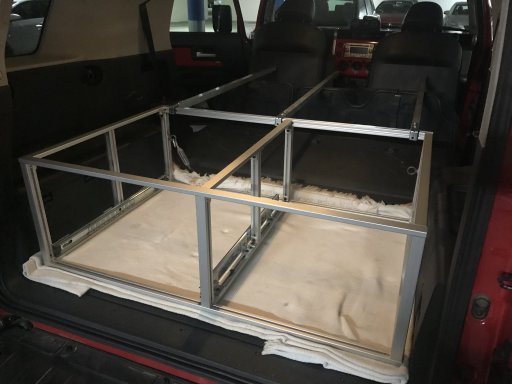
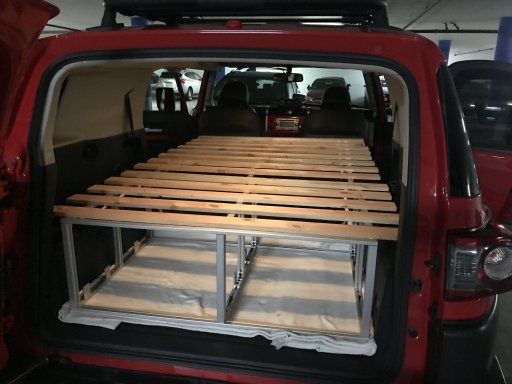
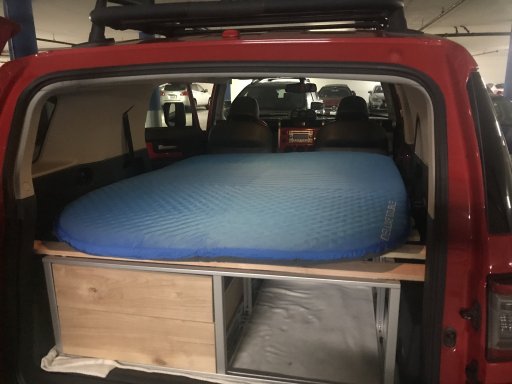
These are miscellaneous photos of the components/construction:
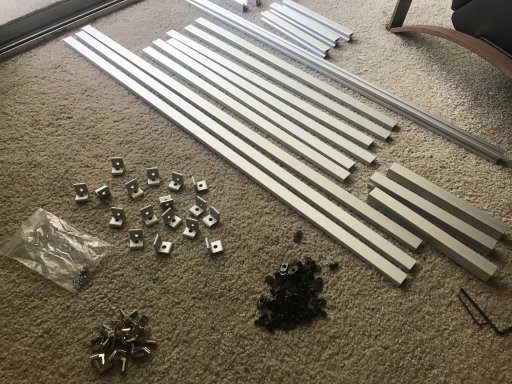
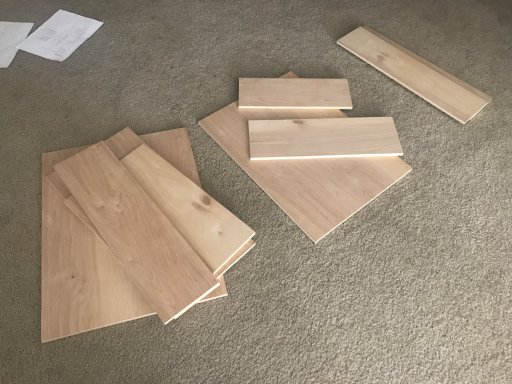
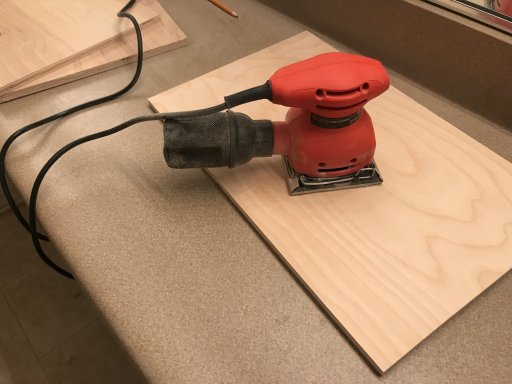
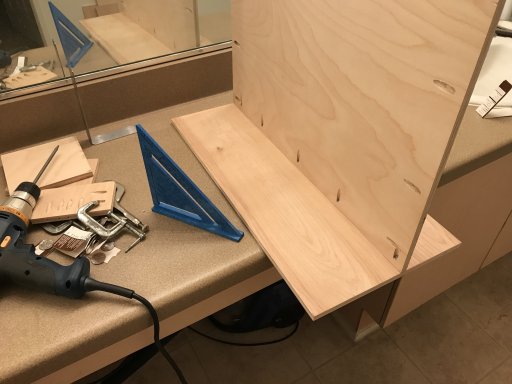
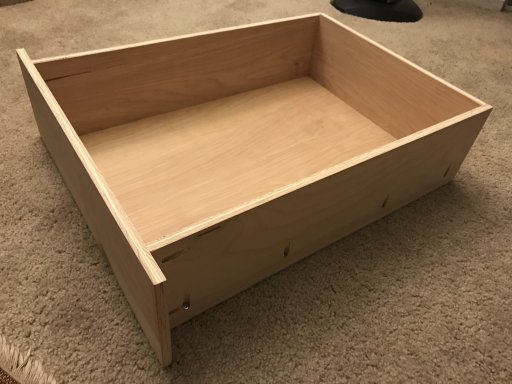
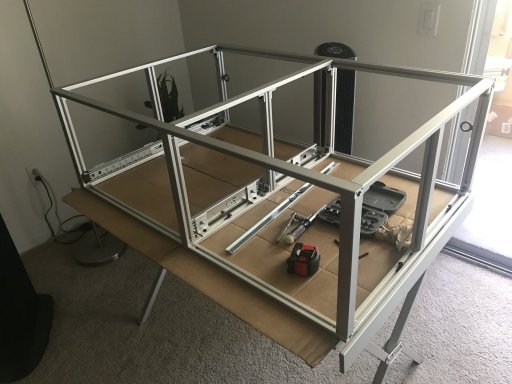
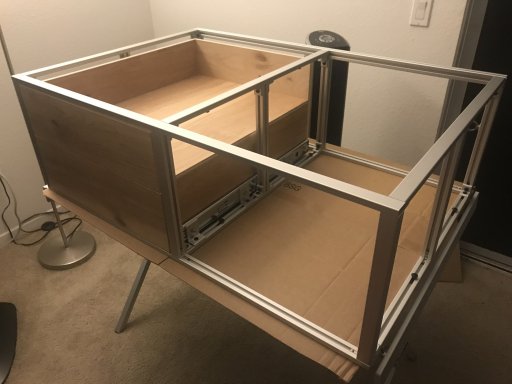
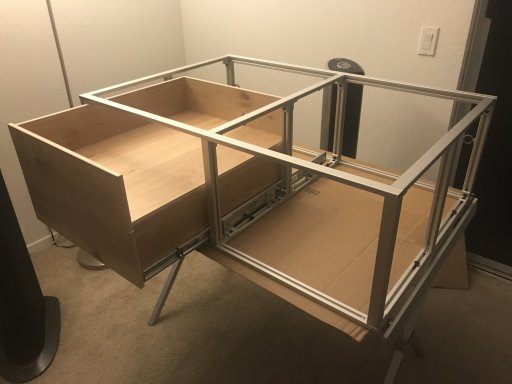
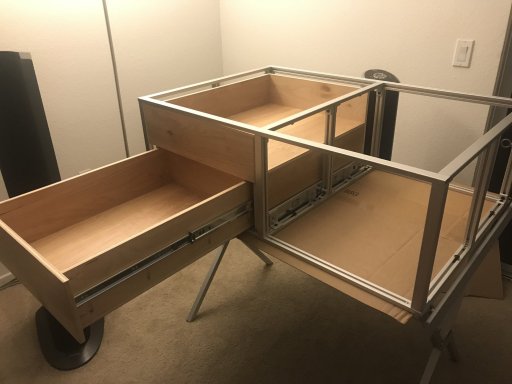
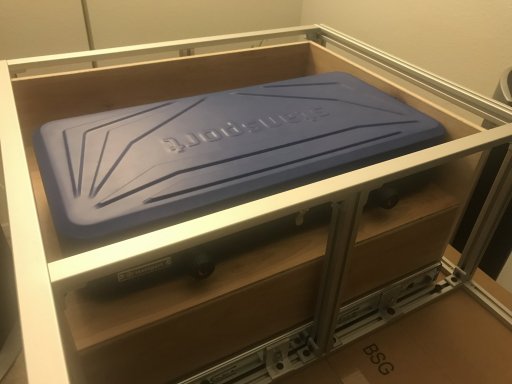
My guiding principles were:
1. Keep it as lightweight as possible
2. Accommodate a drawer fridge
3. Drawer system had to be easily removable (no permanent attachments)
4. Platform bed needed to be removable and easily transportable to/from vehicle
5. Rear seats had to stay in the vehicle
6. Had to look good :)
Here’s what the finished drawer system looks like. The opening on the right will accommodate a Dometic CD-30 or equivalent drawer fridge, and a smaller drawer above it (coming in the future). All the brackets are already in place so mounting these things later on will be very easy.

To make the platform for the bed, I made three aluminum bars that engage with the back of the drawer frame on one side, and sit on top of the folded-up rear seats on the other. If you don't have the latter in your vehicle you would have to make some sort of leg for these bed spanners. The wood slats, which are pinned to the bars so the system becomes rigid after installed, obviously go on top of the three spanner bars. The slats and bars fit into a long duffel bag that is in a closet until I am going on a camping trip.

The drawer frame structure is lightweight and made out of extruded aluminum. You will notice it is an open frame, as the aluminum is strong enough as it is and thus I did not need walls, etc. and I wanted to keep the weight down. It is held firmly in place in the rear with two turnbuckles (only the left one is installed in this picture). You will see that the rear seat backs are reclined flat, and the bottoms are pivoted up. The top of these provides the support for the bed spanners.

The drawer system is made of 1/2” Baltic plywood, assembled with pocket screws. I was planning to dissasemble the whole thing after making sure everything worked well and reassemble with wood glue and the pocket screws, but the structure was so strong with just the screws I did not bother with the glue. The big drawer slides on a 26” drawer glide and the one inside slides on a 24” drawer glide. They are push to open, so I installed a cam lock to hold them firmly in place while traveling.
The bottom (internal) drawer is meant for pots and pans, plates, and other miscellaneous cooking gear. The reason why that comes out of the big drawer instead of directly out of the aluminum frame is because if I was cooking and I needed to take something out of the bottom drawer I would have to shut off the stove and close it so I could open the bottom drawer and retrieve something from there. The nesting drawers solves this problem.
The big drawer has the cooking platform above which holds the 2 burner cooking stove, which in turn is attached to the floor of the platform with industrial strength Velcro. The 1lb propane bottle goes in the gap behind the stove, and connects to the stove with a flexible hose/regulator instead of the solid brass pipe/regulator that comes with the stove (which goes to the right of the stove, but I did not have the space for).




To install the platform bed, the front seats slide forward. The back rests also recline forward. It turns out that the driver seat back rest in the FJ Cruiser does not recline forward as much as the passenger seat so I had to perform surgery on the mechanism that controls this so now both recline the same, and provides sufficient room for the bed comfortable for a 6'1" person.
The rear seat bottoms recline forward and the back rests recline down, and the bed spanner bars attach to the top/rear of the drawer frame on one end using an L bracket and sit on the top part of the bottom seats on the other end. On top of that goes the wood slats and on top of that the mattress pad. The space above is not big, but it’s sufficient to turn around. The biggest challenge is getting in and out of the vehicle, but anyone reasonably fit can easily do it. If someone is claustrofobic this might not be a good solution but it does provide comfortable sleeping space for two. And, under the three bars (and on top of the rear back rests) there’s a giant 22cm tall space (and as wide as the vehicle and 113cm long) for storage of water jerry can and any other things you will need to carry.



These are miscellaneous photos of the components/construction:















